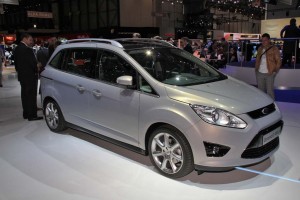
Coming to America - under the Ford C-Max nameplate, the European version of this "people mover" carries a Grand C-Max badge.
More than a quarter-century after Chrysler launched the first truly mainstream minivan, Ford Motor Co. remains a company in search of its own alternative.
It’s not that Ford hasn’t tried; far from it. It has tried repeatedly to crack a segment of the market that once generated sales of well over one million vehicles annually – most notably with the long-running Windstar. The first time out of the box, Ford boasted that its approach offered 99 advantages over Chrysler’s competing entries, which then included such models as the Plymouth Voyager and Dodge Caravan. But buyers would have nothing of it.
Time and again, Ford fell short, finally abandoning the classic minivan segment after the abortive Freestar fell flat.
If you can’t dominate an existing market segment, automakers have come to believe, the best approach is to create a new segment of your own – which Ford tried, two years ago, with the introduction of the Flex “people mover.” Flex is a solid and impressive vehicle, all the more so after you spend some time behind the wheel. But its long, boxy shape and the lack of sliding doors – a minivan staple – have hurt it in the market, where Flex continues to lag far behind the two current Chrysler minivan offerings, as well as the various Japanese competitors that have increasingly gained strength over the years.
But Ford will be back, even if the company does continue to stick with the term, people mover, rather than minivan, for the 2012 C-Max that it formally unveiled in Europe, earlier this year – and which will get its first American showing at the upcoming Detroit Auto Show.
The C-Max was developed as part of CEO Alan Mulally’s One Ford strategy. Ford most of the automaker’s century-long history it has operated as a collection of regional fiefdoms. Today, however, Ford’s goal is to interconnect Asia and the Americas, as well as Europe and the Middle East – developing an array of global products that can be subtly tweaked to meet local needs. The recently launched Fiesta is one example, the new Ford Focus another.
About 80% of the parts and components on the European and North American Focus models will be shared, significantly reducing costs and, Ford claims, helping improve quality. To further boost economies of scale, Focus makes use of the underlying Global C-Car platform, a common “architecture,” in industry-speak, that will eventually be shared by 10 different products that Ford expects to generate sales of 2 million or more vehicles annually.
To confuse the situation a bit, what we North Americans will call the C-Max will be known as the Grand C-Max in Europe. The primary emphasis, in that crowded market, will be on a slightly smaller people mover that will share the C-Max name.
Complex, perhaps, but it reflects the fact that even with $3-a-gallon gas – and the threat that the numbers on the pump will soon hit $4 – Americans still can’t quite get used to the pint-sized offerings common in Europe and much of the rest of the world.
What we will call the C-Max is still small enough, a fair bit tinier than the original, 1984 versions of Chrysler’s groundbreaking Voyager and Caravan short-wheelbase models. Nonetheless, the 2012 Ford C-Max is an impressive offering, (Click Here for TheDetroitBureau.com’s full review.) It’s hard to imagine getting seven people into the vehicle, let alone a suitcase or two.
That said, can Ford finally make a serious pitch to the still substantial body of customers who want a vehicle like this, whether you call it a minivan, microvan or people mover?
At a background briefly, Ford laid out its cards. It will promote C-Max as a high-tech alternative, with an impressive array of features such as the under-bumper sensor that lets you open up the power tailgate without a key, as well as the latest safety features, such as Curve Control.
“We think customers are going to love the C-Max’s combined technology, convenience and functionality in such a tidy overall footprint,” said Ford’s group vice president of global product development, Derrick Kuzak.
Fuel efficiency is expected to be another plus. Though Ford hasn’t released final numbers, it’s hinting mileage will be significantly better than for conventionally-sized minivans. Yet, by offering the 2012 C-Max with an optional 4-cylinder version of the EcoBoost engine, buyers will get good performance, as well.
Nonetheless, it’s going to take all the prowess of Jim Farley, Ford’s marketing czar, and his team to simply get the C-Max onto the motoring public’s radar screen. There are already plenty of good options out there, Chrysler’s among them. Despite what you might think about minivans, the Honda Odyssey is one of the 2011 model-year’s hottest new offerings. The Toyota Sienna is holding its own despite the company’s tattered image. And Nissan’s newest Quest remake should be a formidable contender.
Ford simply doesn’t have the track record in the minivan segment, nor the loyal owner body which could be counted on to trade in past people-movers for new ones, a serious disadvantage compared to its domestic and import rivals.
Some might ask why Ford would even bother. Minivan sales plunged from 1.1 million in 1995 to just over 415 thousand last year. But the segment is showing some resilience, gaining 9.3% for the first 11 months of 2010, an increase just slightly behind that of the overall U.S. market. Meanwhile, if Ford really has refined its business model under the One Ford approach, C-Max will be a largely incremental offering and generate significant profit margins.
That said, the 2012 Ford C-Max is impressive enough not to be discounted out of hand, as most industry-watchers did the undistinguished Freestar. It will take a lot of work, but C-Max could finally be the product Ford needs, whatever segment you put it in.
